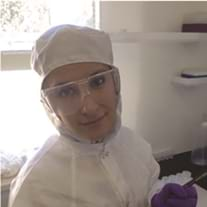Good Mentors are Key to Student Interest in STEM
The Academy’s Scientists in Residence initiative aims to jumpstart student interest in STEM.
Published May 1, 2020
By Adrienne Umali, M.S.B.S., M.S.Ed.
Associate Director, In-Person Education Programs

Associate Research Scientist Geochemistry, Columbia University
Regardless of the field you’re in, it is likely that if you looked back at your career path, you could identify at least one person who has helped guide you to where you are today. Whether this person was a teacher, family member, coach, or supervisor, mentorship has always been an incredibly important part of not only exposing individuals to new ideas and opportunities, but in encouraging them to their full potential.
When the 2018 Program for International Student Assessment (PISA) scores in math and science showed the United States ranked 13th, behind several Asian and European nations, it was once again demonstrated that the U.S. needs to raise its investment in science, technology, engineering and math (STEM) to remain globally competitive. These fields are core to almost every industry, but a 2017 poll found that only 38 percent of middle and high school teachers see their students as being “naturally interested” in STEM.

Science Teacher, Elijah Stroud Middle School, Brooklyn, N.Y.
Cultivating a Love of STEM
Most students rarely have the opportunity to meet a working scientist, so developing programs that expose students to science professionals is proving to be a critical way to cultivate a love of STEM in the next generation. It’s what brought Emily Bohonos, a middle school science teacher in Brooklyn, N.Y., to join The New York Academy of Science’s Scientist-in-Residence (SiR) program.
SiR brings together scientists and NYC middle and high school teachers for a year-long collaboration that aims to jumpstart student interest in STEM through real-world projects and the opportunity to “humanize” a scientist.
Bohonos along with her partner Kathrin Schilling, Ph.D., an associate research scientist of Geochemistry from Columbia University, have spent the last few months creating a project focused on something that most students already have an interest in: food. Building off of Schillings’ expertise — she has degrees in geology, soil science and microbiology — the two are challenging students to research diet variations around the world and create experiments that explore the effects of different conditions on plant growth. Their project pushes students to practice thinking critically, creatively, and globally.
Thinking Outside the Box
Schilling loves sharing her passion for science with students and is thrilled when she sees them thinking outside of the box. The benefits of programs like this, however, are not limited to added content expertise — they also provide tangible examples of people who have found success in STEM.
In fact, Schilling notes that many of the questions she gets are far removed from her area of expertise. With the title of “Dr.“, the students see her as an expert in all science-related fields, a factor she recognizes may be one of the reasons that science can seem inaccessible to some students. “It feels like you have to be a genius in every field [to be a scientist] and we are definitely not.” Schilling admits that she herself wasn’t a great student until she was able to start specializing in her post-secondary education.
To this end, Bohonos creates time during each lesson to allow students to interact one-on-one with their Resident Scientist and get to know her on a personal level. In this way, students can hopefully begin to see STEM as a career path not just limited to those who have already been labeled as “smart”. Fostering this type of environment is particularly critical at schools like Bohonos’, where students of color make up almost 90 percent of the student body, a group which still remains significantly underrepresented in the number of individuals receiving undergraduate STEM degrees.
Mentoring takes time and it comes with its own challenges, but despite this, Schilling remains optimistic about her role in fostering a positive outlook regarding STEM. “Even if I can change the mind of just a few [students] it’s more than before the program.
